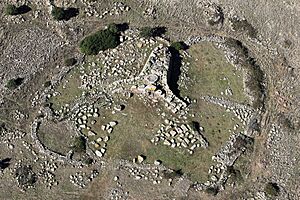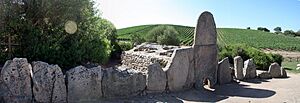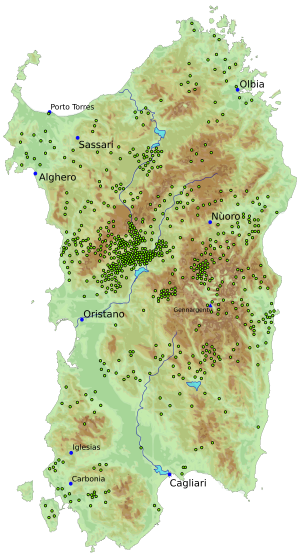Giants' grave facts for kids

A Giants' tomb is a special kind of ancient burial place found on the island of Sardinia in Italy. Local people and archaeologists gave them this name because they are very large. These tombs were built by the Nuragic civilization during the Bronze Age, a long time ago.
Giants' tombs were used to bury many people together. They are a type of megalithic gallery grave, which means they are made from very big stones. You can find about 800 of these tombs all over Sardinia. A pile of stones, called a cairn, usually covers the burial rooms. Some tombs even have an entrance shaped like a cup, similar to old tombs in Ireland.
Contents
Types of Giants' Tombs

There are two main types of Giants' tombs, based on how they were built.
Slab Type Tombs
The first type is called the "slab type." These tombs are made from large, flat stones (slabs) that are placed upright in the ground, side by side.
A very large stone, called a central stele, stands at the front. This stele can be up to 4 meters (about 13 feet) tall. It has a special doorway cut right through it, which is the entrance to the tomb.
In the older slab-type tombs, the central stone was mostly natural, with just the entrance cut out. Sometimes, three rough stones were arranged to form the entrance. Examples include Osono and Lolghi.
In newer slab-type tombs, the central stone was shaped more carefully. Its top was rounded, and sometimes simple designs were carved into its front. You can see these at places like Coddu Vecchju.
The burial room inside these tombs is usually long and narrow, like a rectangle with a rounded end. It's typically about 5 to 15 meters (16 to 49 feet) long and 1 to 2 meters (3 to 6 feet) high. The whole structure was once covered by a mound of earth or stones. This mound often looked like an overturned ship.
Near the entrance, you might find a tall stone pillar called an obelisk (or betile in Sardinian). These pillars were thought to represent gods or ancestors who protected the people buried inside.
Block Type Tombs
The second type of Giants' tomb is the "block type." These tombs are built using stones that have been cut into rectangular blocks. This made them look more organized and precise. Examples include Bidistili and Madau II.
Similar stone structures can also be found in other places, like the island of Malta, parts of the United Kingdom, and Menorca (where they are called navetas).
Where to Find Giants' Tombs
Giants' tombs are spread across the entire island of Sardinia. Here are some of the most well-known ones:
- Su Mont'e s'Abe, near Olbia
- Sa Dom'è s'Orcu, near Quartucciu
- Two tombs from the 18th century BC near Lanusei
- Aiodda, near Nurallao
- Coddu Vecchiu and Li Lolghi, both in Arzachena
- Sa Dom'è s'Orcu, in Siddi
- Imbertighe, in Borore
- Madau, in Fonni
- Muraguada, in Bauladu
- Osono, near Triei
- Tomb of San Cosimo, near Gonnosfanadiga
- S'Ena'e Thomes, in Dorgali
- Bainzu, in Borore
- Sa Farch'e S'Artare, in Seneghe
See also
- Nuraghe
- Naveta
- In Spanish: Tumba de los gigantes para niños
Images for kids
-
Giant's grave of S'Arena, Urzulei
-
Giant's grave of Pascaredda, Calangianus
-
Giant's grave of Is Concias, Quartucciu
-
Giant's grave of Madau, Fonni
-
Giant's grave of Barrancu Mannu, Santadi
-
Giant's grave of Lu Brandali, Santa Teresa Gallura
-
Giant's grave of San Cosimo, Gonnosfanadiga










